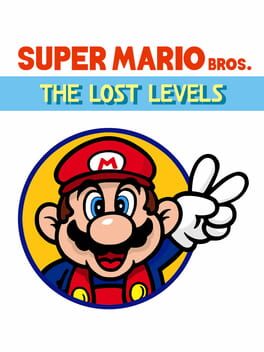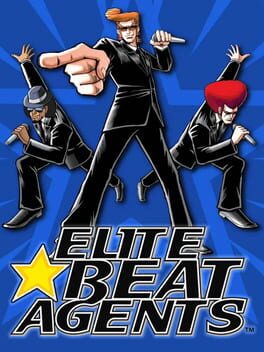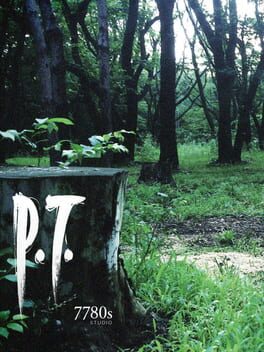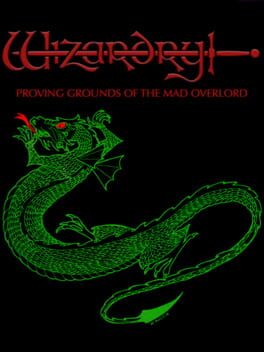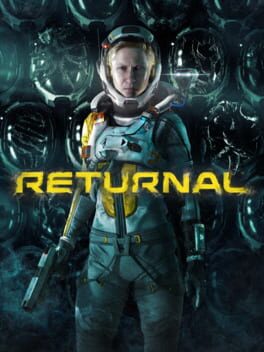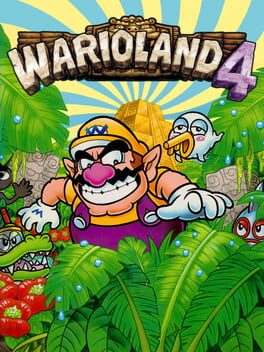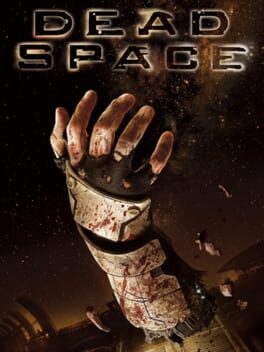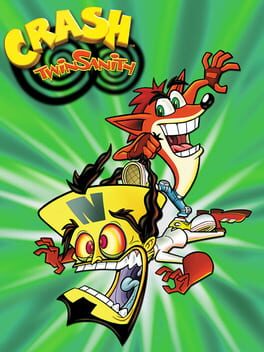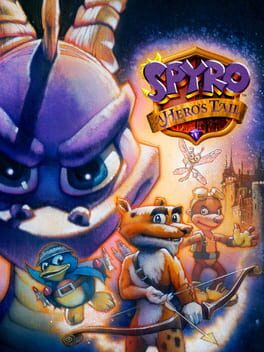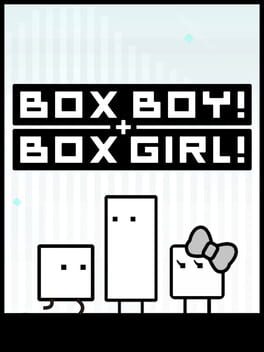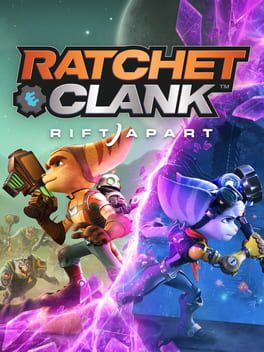DaleBastion
72 Reviews liked by DaleBastion
Viewtiful Joe
2003
Kumdor no Ken
1991
The stuff dreams and nightmares are made of. Earthbound's cosmic horror climax sitting right next to Mavis Beacon touch-typing exercises. A critique and celebration of Dragon Quest not unlike Itoi's Mother series, just more spartan and deadpan. And it's finally translated in English, a privilege few PC-98 games enjoy even today (let alone most '90s East Asian PC software). Kumdor no Ken, or Sword of Kumdor, was creator Michiaki Tsubaki's most popular, well-regarded work during his short stint in games development, an edutainment staple for NEC and Mac computer labs. Many kids and young adults grew up with this, a story-driven word processing trainer for the JRPG age. Its story of exploring a strange land, overcoming bizarre obstacles, and indulging the frivolous but endearing people of this planet resonates with those same players today. Just imagine if Mario Teaches Typing had earned the kind of legacy and following a 16-bit Final Fantasy entry has now. Yet, until very recently, seemingly none in the West knew or cared about this.
| A typing tutor for all seasons |
Maybe I'm just built different, but Sword of Kumdor caught my attention several years ago while I was buzzing around decaying Japanese homepages and fan sites from the pre-Facebook days. It's almost pointillist visual style, learning to touch-type through turn-based combat, and bizarre sense of place and verisimilitude (or sekaikan) beguiled me. The closest Anglosphere equivalents to something this well-made, distinctive, and beloved across demographics are classics like Oregon Trail, or The Logical Journey of the Zoombinis. Whole petitions exist simply for reprints of the game for modern PCs, encased in the same unique book packaging ASCII & Tsubaki used back in 1991. Though my attempts to play through this adventure then were thwarted by the language barrier and poor keyboard skills, I could tell this was no mere fluke, forgery, or overhyped victim of nostalgia. Nothing on consoles, Western PCs, or the PC-98 and its competitors resembled Tsubaki's RPGs, almost all of which taught players about computing, typing, and other subject matter through idiosyncratic RPG stylings and structure. This was something special, and I had to know more. That's why [DISCLAIMER] I ended up being the beta tester on lynn's translation project, now having no excuse but to see this through.
Sword of Kumdor starts off unassuming, with barebones titles and a scrawly tutorial briefly going over controls. Using the F, J, and space keys to move forward, use the menu, and rotate your protagonist sounds weird and unintuitive, but comes naturally as you start the game in a galactic rest stop, waiting to board a rocket towards the titular world. Tsubaki describes our hero(ine) as a "Master of Blind Touch", a keyboard champion who's risen to the top but is bored, desperate for deeper understanding beyond their success on Earth. So we've traveled to a beleaguered, backwater planet calling for help, invaded by strange spellcasting monsters and sudden environmental disasters. It's not long before our own interplanetary trip to Kumdor goes awry, with the spacecraft malfunctioning and crash landing right into the starting town. With our keyboard keys and experience gone, no one recognizes us as the same touch-typing maestro promised to them. It's time to regain our equipment, master those typing skills once more, and figure out the cause of and solution to Kumdor's maladies!
As I've implied, most of the game loop involves exploring towns, overworlds, and dungeons, fighting random battles and collecting key items. This also entails the usual fiddling with inventory and managing your money, but Tsubaki challenges players to do something unique for a JRPG: play the whole game with touch-typing controls. I really cannot imagine how one would get through Sword of Kumdor on a gamepad, nor would it make any sense. From the most basic resting wrist fingerings to rapidly and precisely completing difficult sentences later on, this journey tries to make an avid typist out of anyone, even if its approach can get exhausting. One menu option brings you to a full keyboard HUD displaying your inputs, something I found necessary due to some PC-98 keys not natively mapping onto my US Windows layout. Another menu gives players a summary of their word-per-minute rating and trend over runtime, plus their WPM target which matters most at endgame. Teachers likely needed and asked for these tools the most, but anyone playing this to completion should find 'em useful too. I had to make a new .txt file in my Neko Project II emulator directory rebinding some keys to in-game equivalents, which made the virtual key-map important.
Forget years of button-mashing wearing out your gamepad—this game occasionally had me wondering if I'd finally feel some mushiness from my spacebar! (Not the case, thankfully, but then again my keyboard has faux Cherry Blue switches, designed to remain punchy.) I've long wondered if the Art Academy series could help me unlearn my chickenscratch handwriting and drawing, and parts of Sword of Kumdor did a lot to correct bad typing habits I've built over the ages. Everything centers around your muscle memory here, with slow and clumsy typing punished with Game Overs in combat and puzzles. Battles are all 1-on-1 affairs, as are "gates" which you unlock using the same system. Enemies shout prompts, you type them back as fast and accurate as you can, and this deals damage based on your EXP points total. Increasing max EXP requires visiting practice areas, usually within towns, which check if you've bought the right keys and then test you with them. Completing prompts fast with no errors leads to either an optional prompt at the end of fights—which reward the lion's share of an encounter's EXP as long as you don't mess up once—or a higher raise in max EXP during the aforementioned tests. These slight variations on the same repetitive exercises keeps most of the game feeling fresh despite what it demands from players.
| Old tales, new travails |
Another boon for us all is the Dragon Quest-like game progression, which involves finding and using movement items to proceed further. Though there's only one real "dungeon" stuck in the endgame, crossing each overworld section means talking to the right NPCs (which rarely feels tedious) to acquire the right stuff. For example, a mid-game fog valley barrier proves insurmountable until one locates the compass needed to navigate it. Diving into and out of lakes or ponds? Better snag a snorkel! And because there's no way to passively heal, Sword of Kumdor punishes players who forget to pack restoratives, either found throughout the realm or bought in towns. There's both consumable items with various properties and magic scrolls which only work if you have all the keys needed to type them. (Early on, you won't even have an Enter key with which to submit the spell name.) All this could easily be too simplistic or convoluted like in many contemporary JRPGs, but Tsubaki does a good job of balancing frequent typing with visiting new locations and people often.
If anything, Sword of Kumdor incentivizes its digital stenographers to chat up as many of the locals as possible. So much dialogue between villagers, scientists, and plot-critical individuals goes for light, often ironic or self-effacing conversation, the kind you'd expect from modern Earthbound-inspired xRPGs and adventure (ADV/VN) faire. Lake divers kvetch to you and one another about how the monsters plaguing their lake have left them with nothing good to do. Kumdor-ians complain endlessly about their inability to learn touch-typing and fight back, often resorting to increasingly absurd solutions. Hermits and dilapidated robots muse about the mysterious Dreampoint, which seems to be corrupted and responsible for the planet's septic response to its inhabitants. Sword of Kumdor starts you off as a detached observer of their foibles, humor, and resignation to what fate has in store for them. Only much later on do major NPCs recognize you as the purported "keyboard warrior" they asked for, and even then everybody's too busy trying to live, survive, and enjoy themselves to notice. Nothing in this pre-Mother 2 odyssey from 1991 ever gets as nakedly comical or referential as the usual suspects today, but all the signs are here from start to finish.
Most of an average playthrough (about 6-7 hours prior to endgame) goes by with little issue, intuitive and freshly paced as it is, up until endgame. Trudging through lava flows to reach safe land, or hopping across pits and solving gates, takes a bit more time, but that's far from the worst Tsubaki throws at you. It's the long-awaited final stretch, the Dreampoint, which turns Sword of Kumdor from an occasionally tricky edutainment JRPG into a brutal marathon of skill and carpal tunnel risks. The dungeon's gimmick? Find those warp points and save up enough dosh to buy the house they're hidden inside. While you can safely run from any battle elsewhere in the game, only suffering minor damage or easily healed status conditions if unlucky, most of the baddies patrolling this place can do terrifying things to players. Some render you invisible before curing, others saddle you with an unhealable darkness of vision (only fading if you can escape the Dreampoint), and a couple outright steal one or more keys if you run for it! My strategy evolved towards hoarding restoration food, saving very rare teleportation magic for emergencies, and then trying to brute-force through these oppressive mazy floors until I reached the next warp. Once I'd vanquished the "final boss", this conclusion felt more like the second half, taking as much time as events leading to it (if not more).
This difficulty and investment spike risks spurning players entirely. Indeed, I began to play less, making what progress I could in short sessions to avoid burnout. But it's also exactly the kind of grueling test that Tsubaki (and I presume his friends at ASCII Corp.) had in mind for budding touch-typists. What qualified as dungeons and side-areas before pales in comparison to this crawl, and I think it ultimately works out for the better. I'd reached just shy of 2000 EXP by the end, relying more on my typing skills than just pushing up numbers in the practice rooms when I could two-shot most enemies already. Previous emphasis on building muscle memory and character status gives way to the player themselves embodying their male or female avatar's struggle to save the world. Like the best finales in ye olde Phantasy Star or Ys saga of the era, strategy and self-pacing count more than grinding to a sure victory, and so the push-pull of tension and relief becomes so much stronger in turn. It recontextualizes most of the rest of the game as a cleverly-disguised series of quizzes and reviews, preparing us for this cram school's worth of battles, conundrums, and focused sprints to safety. And, being the masochist I am (not unlike '90s Japanese students here), I was hooked.
| Mysteries of the inner globe |
The Dreampoint itself summarizes many of the story's most interesting themes and oddities, a labyrinth of disfigured memories and boogeymen foreshadowing the big twist. So far, Sword of Kumdor has presented its planet as a microcosm of Showa-era Japan, with its polite but passive-aggressive populace and a strong bystander effect despite the unforeseen consequences of the planet's sentient core being invaded. Just like how the gravy train of real estate speculation and over-lending led to the bubble bursting not long before Tsubaki made this, Kumdor's palace royals and courtiers' fascination with the Dreampoint, a crossing point of everyone's conscious and subconscious thoughts, led to an ecological apocalypse of sorts. As a decorated yet anonymous outsider to these problems—the "Westerner" in the equation, not knowing local history, problems, etc.—it's just as problematic that we have to bail the leaders out of this predicament. Even as we help citizens and eventually the ultimate victim of the Dreampoint, what gratitude we receive comes mostly from observable touch-typing mastery. Think about whenever your boss or workplace values you most for results and business contributions, more so than just being, having that humanity and empathy we desire yet undervalue.
Beneath all the hijinks, calamities, and talking to sentient key-trees and key-fish lies a critical but optimistic set of messages for kids and adults in modern life. Through talent, determination, and side-stepping structural barriers whenever/wherever possible, one can recover from setbacks and prosper in ways previously unfathomed. By understanding one's environment and believing in your abilities—not taking things for granted or falling into impostor syndrome—you can convince the world around you of your worth, even if it shouldn't need such arguing. I appreciate what Tsubaki successfully communicates here even more because it does so without any hint of didacticism. Each ending, based on your endgame WPM target, reflects somewhat upon what comes after this arduous journey, be it the "bad" ending having Kumdor's king advocate for consuming oneself in fantasy (the book he wants to get back to instead of talking more with you), or the best ending having a couple of royals earnestly ask for you to tutor them in the touch-typing ways. Key NPCs only realize you're the Master of Blind Touch after your actions and progress prove that so, and the ancient non-Kumdorian inhabitants of the land, from wisened tree and fish folk to the mangled but salient denizens of the Dreampoint, comment on how far you've come without overselling the point. On the contrary, that "regular guy in the street" in Kumiel, the capital, doesn't pay players any mind, instead encouraging us to think about their relative privileges while other, more talkative folks escape volcanic eruptions or watch their jobs stagnate.
—————Ending spoilers below!—————
Something tells me Tsubaki was nonetheless reverent towards the principles of Yuji Horii's work on adventures like Portopia Serial Murder Case and, of course, the inescapable Dragon Quest franchise from '86 onward. Our protagonist's trip from wrecked ship to the neural nexus of this world both mirrors and reimagines Loto's quest in the original JRPG. Rather than starting in an open, hospitable castle with its jolly version of Lord British, we only reach the palace later on, just to be turned away because the real Master of Blind Touch would have solved everyone's problems already. Instead of a charismatic Dragonlord tempting players with a chance to join his side, the Dreampoint itself has parasitically merged with Mido, the prince of Kumdor whose own fears, flaws, and insecurities have bequeathed indescribable terrors upon the realm. Here the choice isn't whether or not to join evil, but to let yourself down at the bitter end, leaving this game's Loto to fester as a figurative child of Omelas.
Key moments in the original Dragon Quest's progression are rearranged, malformed, and presented to players no doubt familiar with JRPG cliches as something genuinely new. Bosses aren't cartoony Akira Toriyama drawings, but huge text prompts mixing in text from sources as wide as fairy tales (Snow White), journalism (a summary of '80s US-Japan relations and the Plaza Accord), and other unsettlingly real or familiar subject matter. Hotels go from quaint to multi-floor behemoths, medieval-garbed shopkeepers to lumpy blanks, and soundtracks from cheerful tunes to bright but ominous interludes. Even the biomes are now hostile: white fog traps you in a loop of encounters, water rapids destroy you underwater, and the undulating "void" of the Dreampoint's penultimate room can swallow you whole. In this messed-up but discernable reconfiguration of Dragon Quest-isms, much like the non sequiturs posed to players in something like Space Funeral, we're asked to rethink how much these tropes matter. After all, in a universe where the keyboard's mightier than the sword, what defines a hero's journey, the stakes in general, and how others perceive it all?
—————No more spoilers!—————
Shigesato Itoi often gets a truckload of credit in modern video games discourse for this kind of effortless, trenchant conveyance and literary game design. I think it's sobering to encounter other examples of such creators, working with their own restrictions and life stories, achieving much the same but to far less acclaim and/or recognition. Sword of Kumdor treats its participants with so much intelligence, no matter where you're from or which stage of your lifetime, that it can implicitly pass for an alternative-universe Mother series entry with such ease that I'm a little jealous. Here's exactly the kind of iterative yet unconventional trip through engaging systems, encounters, and heartwarming moments which I hoped existed somewhere in the Japanese PC games library, knowing its breadth and variety. Yes, this is far from a perfect game, what with its harsh dexterity requirements and cliff wall of an ending gauntlet. The audiovisuals, though very striking and identifiable, also play to the 16-color, high-resolution, FM-synthesized hardware in abrasive ways. Not everyone's gonna love eye-searing monsters, pulsing percussion-less and alien aural textures, or the Eisenstein-like use of strong colors to denote sleeping at inns or dying ingloriously in battle. But it all comes together to make something truly "PC-98" for me, a defining piece of entertainment which defies current assumptions about what one can and should expect.
| A sword for Kumdor, my axe for J-PC games scorned |
Years of Tumblr visual blogs, jokes about Sex 2, and the understandable but oft misleading characterization of the PC-98 as an erotic adventures platform makes Sword of Kumdor stand out that much more. It's definitely on the extreme, experimental end of the system's library, but quite the counter-example to explain how differently Japanese users perceived NEC's dominant PC up until Windows 95. True, otaku subcultures and reliable sales of horny soft to those audiences prevailed from the turn of the '90s to today, but the PC-98 catered to so many niche markets, like wargaming and fantasy JRPGs. Reductionist, convenient portrayals of this platform, both in and outside its original regions, downplay or even eliminate the chances that iconic games like Kumdor get the appreciation they deserve. And this isn't a close-and-shut case of Tsubaki's RPGs being the exception to the rule, as many other sims, ADVs, and RPGs didn't rely on any erotica to sell and stand out, ex. Yougekitai's occult detective premise or Tokio's satirical comedy of bubble-era economy and politics. It's a shame that the kind of enthusiast press and institutional promotion that all-ages games like Zoombinis gets in the US hasn't extended to Kumdor in its home country, working against all the fans' nostalgia and agitation to bring it back into the mainstream like it's the early '90s again.
For me, the critical burial and mere rumblings of relevance emanating in Sword of Kumdor's wake seems unjust. (Yes, I know life isn't fair and that these are just first-world problems, but gimme some slack here.) Writer, designer, and programmer Michiaki Tsubaki came from an outsider background in art design to iterate on the popular Dragon Quest mold in ways no one else accomplished. And it makes perfect sense he'd choose the PC-98, simultaneously a bastion for the business world and close-knit interest groups, to house these beguiling, often subversive adventures of learning. Yet so many out West (as well as in Japan, though much less so among uses/players from its heyday) can simply say "the PC-98 is for porn, or Touhou, or mahjong", etc. and leave it at that. I'm not going to say they're bad or wrong, given the large amount of eroge and "weird Japan" software you can find for the system, but Tsubaki didn't dabble in weirdness or exotica for its own sake, let alone fashion or vibes culture. His interactive media seeks to enthrall and unsettle people as much as help and inspire them, using these super-deformed, cute-yet-not elements and methods. In a sense, what he did with Kumdor, the INSIDERS duology, and Toki no Shirube adheres more to a traditional fully-fledged aesthetic than some superficial trend. And that's something I see with a general majority of PC-98 games, even some eroge ADVs.
In short, there's so much more to the PC-98 scene (and PC-88, and MSX, and…better stop here) in terms of daring, diverse, and dare I say important gaming experiences which Sword of Kumdor exemplifies. We can't settle for placing YU-NO or Rusty atop curated, canonical lists of the platform's greats and also overlook ambitious/art works like this, not unless all that matters is just ogling these games and their histories at a glance. (Again, I love quite a bit of eroge and better-known PC-X8 darlings, but they're not the end-all-be-all.) Tsubaki was just one talented bedroom-coding polymath among many in that milieu, pushing unwieldy hardware to its limits and daring players to keep up. Our unlikely Master of Blind Touch journeys from the end of one life into the beginnings of another, reassembling a broken world's hopes and dreams from above and within its core. That reconstructive mentality resonates with me, someone who's always willing to give these old, janky but often great PC games their due. You could find all kinds of ideas, stories, genre hybrids, different design paradigms, and truly unique fantasies and realities across East Asian PC games like this, complementing the console/arcade landscape with what those couldn't or didn't provide.
That said, it's not super easy for me to recommend this to anyone starting out with PC-98 emulation or using a real machine. I can think of very few notable games on the system which need this much keyboard configuration to feel all that great to play in long bouts. But it's still one of the most interesting xRPGs on the system—hell, in these genres' history! Not many stories can wield weirdness with purpose and the right amount of restraint like this. Not many edutainment titles dare their players to head into dangerous, troubling circumstances either. And not many are willing to risk players' attention and comfort for the sake of a tonally consistent, draining final act which wraps all loose ends, game loops, and story motifs into one. I have nothing but respect and admiration for Tsubaki's efforts here, and his lack of presence and biographical info even within Japan just saddens me. Regardless, I deem Sword of Kumdor the best way to get into this designer's catalog of bizarre yet relatable JRPGs, with the more computer science-based INSIDERS and Gaia-themed Stellar Sign comprising the rest of these PC-98 tomes. Of course, one might argue we're not getting the whole experience without translations of the dense hintbooks provided with each Tsubaki release, something ASCII Corporation did to help players and persuade educators to include the games in their curricula. But this first translation patch will definitely suffice!
| A typing tutor for all seasons |
Maybe I'm just built different, but Sword of Kumdor caught my attention several years ago while I was buzzing around decaying Japanese homepages and fan sites from the pre-Facebook days. It's almost pointillist visual style, learning to touch-type through turn-based combat, and bizarre sense of place and verisimilitude (or sekaikan) beguiled me. The closest Anglosphere equivalents to something this well-made, distinctive, and beloved across demographics are classics like Oregon Trail, or The Logical Journey of the Zoombinis. Whole petitions exist simply for reprints of the game for modern PCs, encased in the same unique book packaging ASCII & Tsubaki used back in 1991. Though my attempts to play through this adventure then were thwarted by the language barrier and poor keyboard skills, I could tell this was no mere fluke, forgery, or overhyped victim of nostalgia. Nothing on consoles, Western PCs, or the PC-98 and its competitors resembled Tsubaki's RPGs, almost all of which taught players about computing, typing, and other subject matter through idiosyncratic RPG stylings and structure. This was something special, and I had to know more. That's why [DISCLAIMER] I ended up being the beta tester on lynn's translation project, now having no excuse but to see this through.
Sword of Kumdor starts off unassuming, with barebones titles and a scrawly tutorial briefly going over controls. Using the F, J, and space keys to move forward, use the menu, and rotate your protagonist sounds weird and unintuitive, but comes naturally as you start the game in a galactic rest stop, waiting to board a rocket towards the titular world. Tsubaki describes our hero(ine) as a "Master of Blind Touch", a keyboard champion who's risen to the top but is bored, desperate for deeper understanding beyond their success on Earth. So we've traveled to a beleaguered, backwater planet calling for help, invaded by strange spellcasting monsters and sudden environmental disasters. It's not long before our own interplanetary trip to Kumdor goes awry, with the spacecraft malfunctioning and crash landing right into the starting town. With our keyboard keys and experience gone, no one recognizes us as the same touch-typing maestro promised to them. It's time to regain our equipment, master those typing skills once more, and figure out the cause of and solution to Kumdor's maladies!
As I've implied, most of the game loop involves exploring towns, overworlds, and dungeons, fighting random battles and collecting key items. This also entails the usual fiddling with inventory and managing your money, but Tsubaki challenges players to do something unique for a JRPG: play the whole game with touch-typing controls. I really cannot imagine how one would get through Sword of Kumdor on a gamepad, nor would it make any sense. From the most basic resting wrist fingerings to rapidly and precisely completing difficult sentences later on, this journey tries to make an avid typist out of anyone, even if its approach can get exhausting. One menu option brings you to a full keyboard HUD displaying your inputs, something I found necessary due to some PC-98 keys not natively mapping onto my US Windows layout. Another menu gives players a summary of their word-per-minute rating and trend over runtime, plus their WPM target which matters most at endgame. Teachers likely needed and asked for these tools the most, but anyone playing this to completion should find 'em useful too. I had to make a new .txt file in my Neko Project II emulator directory rebinding some keys to in-game equivalents, which made the virtual key-map important.
Forget years of button-mashing wearing out your gamepad—this game occasionally had me wondering if I'd finally feel some mushiness from my spacebar! (Not the case, thankfully, but then again my keyboard has faux Cherry Blue switches, designed to remain punchy.) I've long wondered if the Art Academy series could help me unlearn my chickenscratch handwriting and drawing, and parts of Sword of Kumdor did a lot to correct bad typing habits I've built over the ages. Everything centers around your muscle memory here, with slow and clumsy typing punished with Game Overs in combat and puzzles. Battles are all 1-on-1 affairs, as are "gates" which you unlock using the same system. Enemies shout prompts, you type them back as fast and accurate as you can, and this deals damage based on your EXP points total. Increasing max EXP requires visiting practice areas, usually within towns, which check if you've bought the right keys and then test you with them. Completing prompts fast with no errors leads to either an optional prompt at the end of fights—which reward the lion's share of an encounter's EXP as long as you don't mess up once—or a higher raise in max EXP during the aforementioned tests. These slight variations on the same repetitive exercises keeps most of the game feeling fresh despite what it demands from players.
| Old tales, new travails |
Another boon for us all is the Dragon Quest-like game progression, which involves finding and using movement items to proceed further. Though there's only one real "dungeon" stuck in the endgame, crossing each overworld section means talking to the right NPCs (which rarely feels tedious) to acquire the right stuff. For example, a mid-game fog valley barrier proves insurmountable until one locates the compass needed to navigate it. Diving into and out of lakes or ponds? Better snag a snorkel! And because there's no way to passively heal, Sword of Kumdor punishes players who forget to pack restoratives, either found throughout the realm or bought in towns. There's both consumable items with various properties and magic scrolls which only work if you have all the keys needed to type them. (Early on, you won't even have an Enter key with which to submit the spell name.) All this could easily be too simplistic or convoluted like in many contemporary JRPGs, but Tsubaki does a good job of balancing frequent typing with visiting new locations and people often.
If anything, Sword of Kumdor incentivizes its digital stenographers to chat up as many of the locals as possible. So much dialogue between villagers, scientists, and plot-critical individuals goes for light, often ironic or self-effacing conversation, the kind you'd expect from modern Earthbound-inspired xRPGs and adventure (ADV/VN) faire. Lake divers kvetch to you and one another about how the monsters plaguing their lake have left them with nothing good to do. Kumdor-ians complain endlessly about their inability to learn touch-typing and fight back, often resorting to increasingly absurd solutions. Hermits and dilapidated robots muse about the mysterious Dreampoint, which seems to be corrupted and responsible for the planet's septic response to its inhabitants. Sword of Kumdor starts you off as a detached observer of their foibles, humor, and resignation to what fate has in store for them. Only much later on do major NPCs recognize you as the purported "keyboard warrior" they asked for, and even then everybody's too busy trying to live, survive, and enjoy themselves to notice. Nothing in this pre-Mother 2 odyssey from 1991 ever gets as nakedly comical or referential as the usual suspects today, but all the signs are here from start to finish.
Most of an average playthrough (about 6-7 hours prior to endgame) goes by with little issue, intuitive and freshly paced as it is, up until endgame. Trudging through lava flows to reach safe land, or hopping across pits and solving gates, takes a bit more time, but that's far from the worst Tsubaki throws at you. It's the long-awaited final stretch, the Dreampoint, which turns Sword of Kumdor from an occasionally tricky edutainment JRPG into a brutal marathon of skill and carpal tunnel risks. The dungeon's gimmick? Find those warp points and save up enough dosh to buy the house they're hidden inside. While you can safely run from any battle elsewhere in the game, only suffering minor damage or easily healed status conditions if unlucky, most of the baddies patrolling this place can do terrifying things to players. Some render you invisible before curing, others saddle you with an unhealable darkness of vision (only fading if you can escape the Dreampoint), and a couple outright steal one or more keys if you run for it! My strategy evolved towards hoarding restoration food, saving very rare teleportation magic for emergencies, and then trying to brute-force through these oppressive mazy floors until I reached the next warp. Once I'd vanquished the "final boss", this conclusion felt more like the second half, taking as much time as events leading to it (if not more).
This difficulty and investment spike risks spurning players entirely. Indeed, I began to play less, making what progress I could in short sessions to avoid burnout. But it's also exactly the kind of grueling test that Tsubaki (and I presume his friends at ASCII Corp.) had in mind for budding touch-typists. What qualified as dungeons and side-areas before pales in comparison to this crawl, and I think it ultimately works out for the better. I'd reached just shy of 2000 EXP by the end, relying more on my typing skills than just pushing up numbers in the practice rooms when I could two-shot most enemies already. Previous emphasis on building muscle memory and character status gives way to the player themselves embodying their male or female avatar's struggle to save the world. Like the best finales in ye olde Phantasy Star or Ys saga of the era, strategy and self-pacing count more than grinding to a sure victory, and so the push-pull of tension and relief becomes so much stronger in turn. It recontextualizes most of the rest of the game as a cleverly-disguised series of quizzes and reviews, preparing us for this cram school's worth of battles, conundrums, and focused sprints to safety. And, being the masochist I am (not unlike '90s Japanese students here), I was hooked.
| Mysteries of the inner globe |
The Dreampoint itself summarizes many of the story's most interesting themes and oddities, a labyrinth of disfigured memories and boogeymen foreshadowing the big twist. So far, Sword of Kumdor has presented its planet as a microcosm of Showa-era Japan, with its polite but passive-aggressive populace and a strong bystander effect despite the unforeseen consequences of the planet's sentient core being invaded. Just like how the gravy train of real estate speculation and over-lending led to the bubble bursting not long before Tsubaki made this, Kumdor's palace royals and courtiers' fascination with the Dreampoint, a crossing point of everyone's conscious and subconscious thoughts, led to an ecological apocalypse of sorts. As a decorated yet anonymous outsider to these problems—the "Westerner" in the equation, not knowing local history, problems, etc.—it's just as problematic that we have to bail the leaders out of this predicament. Even as we help citizens and eventually the ultimate victim of the Dreampoint, what gratitude we receive comes mostly from observable touch-typing mastery. Think about whenever your boss or workplace values you most for results and business contributions, more so than just being, having that humanity and empathy we desire yet undervalue.
Beneath all the hijinks, calamities, and talking to sentient key-trees and key-fish lies a critical but optimistic set of messages for kids and adults in modern life. Through talent, determination, and side-stepping structural barriers whenever/wherever possible, one can recover from setbacks and prosper in ways previously unfathomed. By understanding one's environment and believing in your abilities—not taking things for granted or falling into impostor syndrome—you can convince the world around you of your worth, even if it shouldn't need such arguing. I appreciate what Tsubaki successfully communicates here even more because it does so without any hint of didacticism. Each ending, based on your endgame WPM target, reflects somewhat upon what comes after this arduous journey, be it the "bad" ending having Kumdor's king advocate for consuming oneself in fantasy (the book he wants to get back to instead of talking more with you), or the best ending having a couple of royals earnestly ask for you to tutor them in the touch-typing ways. Key NPCs only realize you're the Master of Blind Touch after your actions and progress prove that so, and the ancient non-Kumdorian inhabitants of the land, from wisened tree and fish folk to the mangled but salient denizens of the Dreampoint, comment on how far you've come without overselling the point. On the contrary, that "regular guy in the street" in Kumiel, the capital, doesn't pay players any mind, instead encouraging us to think about their relative privileges while other, more talkative folks escape volcanic eruptions or watch their jobs stagnate.
—————Ending spoilers below!—————
Something tells me Tsubaki was nonetheless reverent towards the principles of Yuji Horii's work on adventures like Portopia Serial Murder Case and, of course, the inescapable Dragon Quest franchise from '86 onward. Our protagonist's trip from wrecked ship to the neural nexus of this world both mirrors and reimagines Loto's quest in the original JRPG. Rather than starting in an open, hospitable castle with its jolly version of Lord British, we only reach the palace later on, just to be turned away because the real Master of Blind Touch would have solved everyone's problems already. Instead of a charismatic Dragonlord tempting players with a chance to join his side, the Dreampoint itself has parasitically merged with Mido, the prince of Kumdor whose own fears, flaws, and insecurities have bequeathed indescribable terrors upon the realm. Here the choice isn't whether or not to join evil, but to let yourself down at the bitter end, leaving this game's Loto to fester as a figurative child of Omelas.
Key moments in the original Dragon Quest's progression are rearranged, malformed, and presented to players no doubt familiar with JRPG cliches as something genuinely new. Bosses aren't cartoony Akira Toriyama drawings, but huge text prompts mixing in text from sources as wide as fairy tales (Snow White), journalism (a summary of '80s US-Japan relations and the Plaza Accord), and other unsettlingly real or familiar subject matter. Hotels go from quaint to multi-floor behemoths, medieval-garbed shopkeepers to lumpy blanks, and soundtracks from cheerful tunes to bright but ominous interludes. Even the biomes are now hostile: white fog traps you in a loop of encounters, water rapids destroy you underwater, and the undulating "void" of the Dreampoint's penultimate room can swallow you whole. In this messed-up but discernable reconfiguration of Dragon Quest-isms, much like the non sequiturs posed to players in something like Space Funeral, we're asked to rethink how much these tropes matter. After all, in a universe where the keyboard's mightier than the sword, what defines a hero's journey, the stakes in general, and how others perceive it all?
—————No more spoilers!—————
Shigesato Itoi often gets a truckload of credit in modern video games discourse for this kind of effortless, trenchant conveyance and literary game design. I think it's sobering to encounter other examples of such creators, working with their own restrictions and life stories, achieving much the same but to far less acclaim and/or recognition. Sword of Kumdor treats its participants with so much intelligence, no matter where you're from or which stage of your lifetime, that it can implicitly pass for an alternative-universe Mother series entry with such ease that I'm a little jealous. Here's exactly the kind of iterative yet unconventional trip through engaging systems, encounters, and heartwarming moments which I hoped existed somewhere in the Japanese PC games library, knowing its breadth and variety. Yes, this is far from a perfect game, what with its harsh dexterity requirements and cliff wall of an ending gauntlet. The audiovisuals, though very striking and identifiable, also play to the 16-color, high-resolution, FM-synthesized hardware in abrasive ways. Not everyone's gonna love eye-searing monsters, pulsing percussion-less and alien aural textures, or the Eisenstein-like use of strong colors to denote sleeping at inns or dying ingloriously in battle. But it all comes together to make something truly "PC-98" for me, a defining piece of entertainment which defies current assumptions about what one can and should expect.
| A sword for Kumdor, my axe for J-PC games scorned |
Years of Tumblr visual blogs, jokes about Sex 2, and the understandable but oft misleading characterization of the PC-98 as an erotic adventures platform makes Sword of Kumdor stand out that much more. It's definitely on the extreme, experimental end of the system's library, but quite the counter-example to explain how differently Japanese users perceived NEC's dominant PC up until Windows 95. True, otaku subcultures and reliable sales of horny soft to those audiences prevailed from the turn of the '90s to today, but the PC-98 catered to so many niche markets, like wargaming and fantasy JRPGs. Reductionist, convenient portrayals of this platform, both in and outside its original regions, downplay or even eliminate the chances that iconic games like Kumdor get the appreciation they deserve. And this isn't a close-and-shut case of Tsubaki's RPGs being the exception to the rule, as many other sims, ADVs, and RPGs didn't rely on any erotica to sell and stand out, ex. Yougekitai's occult detective premise or Tokio's satirical comedy of bubble-era economy and politics. It's a shame that the kind of enthusiast press and institutional promotion that all-ages games like Zoombinis gets in the US hasn't extended to Kumdor in its home country, working against all the fans' nostalgia and agitation to bring it back into the mainstream like it's the early '90s again.
For me, the critical burial and mere rumblings of relevance emanating in Sword of Kumdor's wake seems unjust. (Yes, I know life isn't fair and that these are just first-world problems, but gimme some slack here.) Writer, designer, and programmer Michiaki Tsubaki came from an outsider background in art design to iterate on the popular Dragon Quest mold in ways no one else accomplished. And it makes perfect sense he'd choose the PC-98, simultaneously a bastion for the business world and close-knit interest groups, to house these beguiling, often subversive adventures of learning. Yet so many out West (as well as in Japan, though much less so among uses/players from its heyday) can simply say "the PC-98 is for porn, or Touhou, or mahjong", etc. and leave it at that. I'm not going to say they're bad or wrong, given the large amount of eroge and "weird Japan" software you can find for the system, but Tsubaki didn't dabble in weirdness or exotica for its own sake, let alone fashion or vibes culture. His interactive media seeks to enthrall and unsettle people as much as help and inspire them, using these super-deformed, cute-yet-not elements and methods. In a sense, what he did with Kumdor, the INSIDERS duology, and Toki no Shirube adheres more to a traditional fully-fledged aesthetic than some superficial trend. And that's something I see with a general majority of PC-98 games, even some eroge ADVs.
In short, there's so much more to the PC-98 scene (and PC-88, and MSX, and…better stop here) in terms of daring, diverse, and dare I say important gaming experiences which Sword of Kumdor exemplifies. We can't settle for placing YU-NO or Rusty atop curated, canonical lists of the platform's greats and also overlook ambitious/art works like this, not unless all that matters is just ogling these games and their histories at a glance. (Again, I love quite a bit of eroge and better-known PC-X8 darlings, but they're not the end-all-be-all.) Tsubaki was just one talented bedroom-coding polymath among many in that milieu, pushing unwieldy hardware to its limits and daring players to keep up. Our unlikely Master of Blind Touch journeys from the end of one life into the beginnings of another, reassembling a broken world's hopes and dreams from above and within its core. That reconstructive mentality resonates with me, someone who's always willing to give these old, janky but often great PC games their due. You could find all kinds of ideas, stories, genre hybrids, different design paradigms, and truly unique fantasies and realities across East Asian PC games like this, complementing the console/arcade landscape with what those couldn't or didn't provide.
That said, it's not super easy for me to recommend this to anyone starting out with PC-98 emulation or using a real machine. I can think of very few notable games on the system which need this much keyboard configuration to feel all that great to play in long bouts. But it's still one of the most interesting xRPGs on the system—hell, in these genres' history! Not many stories can wield weirdness with purpose and the right amount of restraint like this. Not many edutainment titles dare their players to head into dangerous, troubling circumstances either. And not many are willing to risk players' attention and comfort for the sake of a tonally consistent, draining final act which wraps all loose ends, game loops, and story motifs into one. I have nothing but respect and admiration for Tsubaki's efforts here, and his lack of presence and biographical info even within Japan just saddens me. Regardless, I deem Sword of Kumdor the best way to get into this designer's catalog of bizarre yet relatable JRPGs, with the more computer science-based INSIDERS and Gaia-themed Stellar Sign comprising the rest of these PC-98 tomes. Of course, one might argue we're not getting the whole experience without translations of the dense hintbooks provided with each Tsubaki release, something ASCII Corporation did to help players and persuade educators to include the games in their curricula. But this first translation patch will definitely suffice!
Elite Beat Agents
2006
P.T.
2014
‘You have freed the one with yearning eyes whose lot was hunger tragic.’
– Gary Gygax, The Lost Caverns of Tsojcanth, 1982.
Players of the tournament adventure The Lost Caverns of Tsojcanth (1976) were greeted, after some exploration, by prismatic lights dancing on the walls, contrasting with the pile of dark rocks in the centre of the room. Far from being an end in itself, this hall was merely the gateway to the Greater Caverns, where countless secrets were hidden amidst strange stalactites and rock formations conjured from a demented imagination. The treasure of Iggwilv, mysterious as it may be, was only for the bravest of souls. In the 1970s, the development of PLATO, a computer system linking several thousand terminals around the world, led to the emergence of a community of creators who generally made no secret of their inspiration for the dungeon-crawling style typical of the printed RPGs of the time. These first forays set a trend. Among these, Oubliette (1977) perhaps stands out for its remarkable depth for its time: the source of inspiration was clearly Dungeons & Dragons (1974), but the inclusion of attribute tables for the different classes and races, as well as a rich magic system, placed it at the forefront of computer games.
A formula based on Dungeons & Dragons rules
Unlike PLATO, mainstream computer systems did not have the same computing power and early titles could seem like a step backwards. In 1978, Robert J. Woodhead, who had already gained a small notoriety for plagiarising dnd (1975), decided to replicate the system and experience of Oubliette in his own version, promoting an original adventure. The Dungeons & Dragons system is used quite faithfully, and any veteran can create their characters without getting lost. Since multiplayer was not an option, Wizardry recommends creating a team of six characters – or less – to explore the ten underground levels that make up the adventure. As a result, by appropriating the ideas of Oubliette, the title established a canon of standard rules and codes that would have a lasting influence on the dungeon crawler genre.
The player assumes the role of several adventurers whose goal is to venture into the catacombs beneath the castle of King Trebor. Having gone mad after the wizard Werdna stole a precious amulet, he sends young mercenaries to the first floors of the complex where the wizard is hiding. He hopes to find adventurers strong enough to reach the deepest part of the catacombs to kill Werdna and recover the amulet. The tone is rather light and the adventure, though rough in its progression, is punctuated with comic messages; there is something strange about exploring Wizardry, as a light-hearted theatricality contrasts with the often serious and merciless nature of the early Dungeons & Dragons modules.
From the outset, Wizardry requires an investment from the player, who must build their team based on attributes, classes and alignments. A balanced approach is preferred, with three characters in the front attacking with melee weapons, while the backline provides defensive and offensive support with a variety of spells. Character creation oblige, it is possible to abuse the system to get the best possible scores and start with a comfortable roster; likewise, creating characters to take their money is a viable strategy, allowing the player to properly equip themselves before even entering the Proving Grounds. This freedom is reminiscent of the shenanigans possible during TTRPG sessions, and adds to the idiosyncrasy of Wizardry at the time of its release. Traditional reflexes are thus rewarded: the cautious and savvy player will exercise extreme caution, taking care to map effectively and intelligently identify any items recovered from the dungeon.
Some diverse but often obsolete mechanics
The Famicom version, released in 1987, retains these gameplay features, but improves the title with better graphics. The port is largely faithful to the original, with the exception of some floors in the second half of the game, which have been completely redesigned. Even in the Famicom version, the player has to progress slowly and draw their own map to avoid getting lost. However, the first few floors are particularly enjoyable to explore. Wizardry opens elegantly, with Floor 1 divided into quarters, making exploration more digestible. In the first one, the player learns that opening doors is the most common way for the party to engage in combat, and only then can they find chests containing gold and sometimes equipment. Exploration feels organic and natural, with the compartmentalisation ensuring that the player is not drowned out by overly large rooms. Floor 2 follows the same logic, introducing the importance of key objects in the progression: indeed, some areas are inaccessible if the adventurer does not possess the figurines, and the game takes good care to communicate this information through its pseudo-labyrinthine design. Mapping is still fairly straightforward, but takes a bit more time to complete due to the many twists and turns.
At the same time, the player will slowly become accustomed to the combat system. While the backline is generally of no help at the start of the game, as it has no spells, it will gradually become more useful. Once characters have gained enough experience, they can rest at the inn to advance to the next level. Wizardry complicates the process, as not only can certain stats be lowered, but time spent in the inn will cause characters to age and their powers to diminish, before they eventually die. This system may come as a surprise, as it encourages the player not to use the inn excessively as a means of healing. The system does force the player to use the Cleric's spells, but the process tends to be lengthy and the menus are rather cumbersome.
Furthermore, the shop, while useful at first, quickly becomes redundant. The stock is relatively sparse, and the player will easily equip themselves with the best gear available long before exploring the floors where better weapons and armour can be obtained from the monsters. This element makes character progression heavily reliant on enemy grinding – and luck on the chests' table – but renders some mechanics obsolete. In practice, gold coins are only used to visit the temple and remove negative statuses. A similar problem exists with the promotion system: once the attribute and alignment requirements have been met, the player can change a character's class to diversify their options. The problem is that they start with the lowest stats for their race, and it is necessary to grind experience from the start to make the character viable. This emphasis on grinding is at the root of the structural problems in the second half of the game.
Exploration abandoned in favour of grinding: an artificial approach
While the adventure up to Floor 4 remains organic and natural, with a forced encounter forming the game's first genuine obstacle, the following floors lose all interest in ergonomics and decide to take a very aggressive route. The floors become much more complex, with devious traps and frustrating hidden doors. The title introduces anti-magic zones, which severely neutralise the party's abilities – although enemies suffer the same effects. Where the backline, with its crowd control and area attacks, became paramount towards the end of Floor 4, the player is deprived of these options during exploration, making progression much rougher and more difficult. The problem is that the middle floors, 5 to 8, are completely optional. After collecting the Blue Ribbon, players can use the private lift to go directly to any floor between the fourth and ninth, which opens the way to Werdna's lair.
More specifically, the Blue Ribbon is necessary in the progression, as the ninth floor can only be reached by this particular lift. It turns out that the intermediate floors have no other purpose than to be grinding areas. Naturally, the player begins by mapping out the rooms, but when they visit the ninth floor out of curiosity, they realise that all this work is pointless. Because the grind cannot sustain its formula, especially with such a bare interface, the temptation to brute-force the last floor and fight Werdna as quickly as possible is strong. My experience was very similar to the speedrun strategy, as I decided to grind the Giants on Floor 10 to unlock the most powerful offensive spells. Once my Mage was level 13, the final challenge was to survive the gauntlet on the final floor and reach Werdna; at this point, a simple Haman to teleport the boss group ends the game with minimal fuss.
Wizardry remains a challenging title, and the strong dichotomy between the first and second halves is surprising. Could it be that the change in gameplay philosophy is the result of contrasting inspirations? Oubliette offered a fairly straightforward map that, while more open than the early stages of Proving Grounds, was natural and pleasant to explore. Here, the later floors are riddled with cruel traps, such as the three rock columns that instantly punish teleportation with Malor by killing the party with no chance of recovery. This ruthlessness must have been too much for the Japanese team working on the port, as they decided to implement their own floors, which are much more explicit about their optional nature: the hidden stairs in an infinite corridor have been removed, and it is not possible to find the stairway between Floors 7 and 8 without a deliberately creative use of Malor.
The title was an important trailblazer that inspired entire genres of video games, both in the West and in Japan. If it is still possible to experience it in 2023, it is worth remembering the extent to which Wizardry embraces game design ideas that are now considered archaic. The game does not hesitate to punish careless actions and shows no mercy towards unprepared parties, even to the point of permanently eliminating them. The emphasis on grinding, although facilitated by the lifts that allow easy access to the surface, is frustrating. Before reaching level 13, a party can suffer from an encounter that is a little too crowded with enemies, and the player is pressured to reach this threshold before attempting to fight Werdna. As in Tsojcanth, obtaining the Blue Ribbon is only the beginning of the adventure; far scarier things and devious traps await the player, but Wizardry never conjures up the poetic strangeness of these rainbow caverns where unknown and wondrous crystals glisten.
– Gary Gygax, The Lost Caverns of Tsojcanth, 1982.
Players of the tournament adventure The Lost Caverns of Tsojcanth (1976) were greeted, after some exploration, by prismatic lights dancing on the walls, contrasting with the pile of dark rocks in the centre of the room. Far from being an end in itself, this hall was merely the gateway to the Greater Caverns, where countless secrets were hidden amidst strange stalactites and rock formations conjured from a demented imagination. The treasure of Iggwilv, mysterious as it may be, was only for the bravest of souls. In the 1970s, the development of PLATO, a computer system linking several thousand terminals around the world, led to the emergence of a community of creators who generally made no secret of their inspiration for the dungeon-crawling style typical of the printed RPGs of the time. These first forays set a trend. Among these, Oubliette (1977) perhaps stands out for its remarkable depth for its time: the source of inspiration was clearly Dungeons & Dragons (1974), but the inclusion of attribute tables for the different classes and races, as well as a rich magic system, placed it at the forefront of computer games.
A formula based on Dungeons & Dragons rules
Unlike PLATO, mainstream computer systems did not have the same computing power and early titles could seem like a step backwards. In 1978, Robert J. Woodhead, who had already gained a small notoriety for plagiarising dnd (1975), decided to replicate the system and experience of Oubliette in his own version, promoting an original adventure. The Dungeons & Dragons system is used quite faithfully, and any veteran can create their characters without getting lost. Since multiplayer was not an option, Wizardry recommends creating a team of six characters – or less – to explore the ten underground levels that make up the adventure. As a result, by appropriating the ideas of Oubliette, the title established a canon of standard rules and codes that would have a lasting influence on the dungeon crawler genre.
The player assumes the role of several adventurers whose goal is to venture into the catacombs beneath the castle of King Trebor. Having gone mad after the wizard Werdna stole a precious amulet, he sends young mercenaries to the first floors of the complex where the wizard is hiding. He hopes to find adventurers strong enough to reach the deepest part of the catacombs to kill Werdna and recover the amulet. The tone is rather light and the adventure, though rough in its progression, is punctuated with comic messages; there is something strange about exploring Wizardry, as a light-hearted theatricality contrasts with the often serious and merciless nature of the early Dungeons & Dragons modules.
From the outset, Wizardry requires an investment from the player, who must build their team based on attributes, classes and alignments. A balanced approach is preferred, with three characters in the front attacking with melee weapons, while the backline provides defensive and offensive support with a variety of spells. Character creation oblige, it is possible to abuse the system to get the best possible scores and start with a comfortable roster; likewise, creating characters to take their money is a viable strategy, allowing the player to properly equip themselves before even entering the Proving Grounds. This freedom is reminiscent of the shenanigans possible during TTRPG sessions, and adds to the idiosyncrasy of Wizardry at the time of its release. Traditional reflexes are thus rewarded: the cautious and savvy player will exercise extreme caution, taking care to map effectively and intelligently identify any items recovered from the dungeon.
Some diverse but often obsolete mechanics
The Famicom version, released in 1987, retains these gameplay features, but improves the title with better graphics. The port is largely faithful to the original, with the exception of some floors in the second half of the game, which have been completely redesigned. Even in the Famicom version, the player has to progress slowly and draw their own map to avoid getting lost. However, the first few floors are particularly enjoyable to explore. Wizardry opens elegantly, with Floor 1 divided into quarters, making exploration more digestible. In the first one, the player learns that opening doors is the most common way for the party to engage in combat, and only then can they find chests containing gold and sometimes equipment. Exploration feels organic and natural, with the compartmentalisation ensuring that the player is not drowned out by overly large rooms. Floor 2 follows the same logic, introducing the importance of key objects in the progression: indeed, some areas are inaccessible if the adventurer does not possess the figurines, and the game takes good care to communicate this information through its pseudo-labyrinthine design. Mapping is still fairly straightforward, but takes a bit more time to complete due to the many twists and turns.
At the same time, the player will slowly become accustomed to the combat system. While the backline is generally of no help at the start of the game, as it has no spells, it will gradually become more useful. Once characters have gained enough experience, they can rest at the inn to advance to the next level. Wizardry complicates the process, as not only can certain stats be lowered, but time spent in the inn will cause characters to age and their powers to diminish, before they eventually die. This system may come as a surprise, as it encourages the player not to use the inn excessively as a means of healing. The system does force the player to use the Cleric's spells, but the process tends to be lengthy and the menus are rather cumbersome.
Furthermore, the shop, while useful at first, quickly becomes redundant. The stock is relatively sparse, and the player will easily equip themselves with the best gear available long before exploring the floors where better weapons and armour can be obtained from the monsters. This element makes character progression heavily reliant on enemy grinding – and luck on the chests' table – but renders some mechanics obsolete. In practice, gold coins are only used to visit the temple and remove negative statuses. A similar problem exists with the promotion system: once the attribute and alignment requirements have been met, the player can change a character's class to diversify their options. The problem is that they start with the lowest stats for their race, and it is necessary to grind experience from the start to make the character viable. This emphasis on grinding is at the root of the structural problems in the second half of the game.
Exploration abandoned in favour of grinding: an artificial approach
While the adventure up to Floor 4 remains organic and natural, with a forced encounter forming the game's first genuine obstacle, the following floors lose all interest in ergonomics and decide to take a very aggressive route. The floors become much more complex, with devious traps and frustrating hidden doors. The title introduces anti-magic zones, which severely neutralise the party's abilities – although enemies suffer the same effects. Where the backline, with its crowd control and area attacks, became paramount towards the end of Floor 4, the player is deprived of these options during exploration, making progression much rougher and more difficult. The problem is that the middle floors, 5 to 8, are completely optional. After collecting the Blue Ribbon, players can use the private lift to go directly to any floor between the fourth and ninth, which opens the way to Werdna's lair.
More specifically, the Blue Ribbon is necessary in the progression, as the ninth floor can only be reached by this particular lift. It turns out that the intermediate floors have no other purpose than to be grinding areas. Naturally, the player begins by mapping out the rooms, but when they visit the ninth floor out of curiosity, they realise that all this work is pointless. Because the grind cannot sustain its formula, especially with such a bare interface, the temptation to brute-force the last floor and fight Werdna as quickly as possible is strong. My experience was very similar to the speedrun strategy, as I decided to grind the Giants on Floor 10 to unlock the most powerful offensive spells. Once my Mage was level 13, the final challenge was to survive the gauntlet on the final floor and reach Werdna; at this point, a simple Haman to teleport the boss group ends the game with minimal fuss.
Wizardry remains a challenging title, and the strong dichotomy between the first and second halves is surprising. Could it be that the change in gameplay philosophy is the result of contrasting inspirations? Oubliette offered a fairly straightforward map that, while more open than the early stages of Proving Grounds, was natural and pleasant to explore. Here, the later floors are riddled with cruel traps, such as the three rock columns that instantly punish teleportation with Malor by killing the party with no chance of recovery. This ruthlessness must have been too much for the Japanese team working on the port, as they decided to implement their own floors, which are much more explicit about their optional nature: the hidden stairs in an infinite corridor have been removed, and it is not possible to find the stairway between Floors 7 and 8 without a deliberately creative use of Malor.
The title was an important trailblazer that inspired entire genres of video games, both in the West and in Japan. If it is still possible to experience it in 2023, it is worth remembering the extent to which Wizardry embraces game design ideas that are now considered archaic. The game does not hesitate to punish careless actions and shows no mercy towards unprepared parties, even to the point of permanently eliminating them. The emphasis on grinding, although facilitated by the lifts that allow easy access to the surface, is frustrating. Before reaching level 13, a party can suffer from an encounter that is a little too crowded with enemies, and the player is pressured to reach this threshold before attempting to fight Werdna. As in Tsojcanth, obtaining the Blue Ribbon is only the beginning of the adventure; far scarier things and devious traps await the player, but Wizardry never conjures up the poetic strangeness of these rainbow caverns where unknown and wondrous crystals glisten.
Returnal
2021
Returnal somehow still stands in 2023 as one of very few genuinely current-gen-native video games, and you can tell. The graphics are slick, full of shaders, particles, and lighting that underscores its otherworldly vibe. It takes full advantage of the DualSense's haptics to make the game as tactile as it is visual—the half-trigger alt fire mode is particularly impressive in its fluidity of adding what's effectively an extra virtual button to the controller.
My problem is simply that I don't like shooters all that much. All the genuinely challenging fights in this game put a lot of weight onto the player's skill at shooting while dodging and weaving, and I'm neither great at that nor particularly interested in it. In some games, the roguelike design would help compensate for this by giving me the opportunity to assemble a synergy build that can simply overpower enemies despite my middling skill, but that's not Returnal: the build customization here doesn't have the multiplicative scaling necessary to really tap into that mode of play.
So I made it to the final boss of the second biome, died with the last shred of its health remaining, and will probably never return to this game.
My problem is simply that I don't like shooters all that much. All the genuinely challenging fights in this game put a lot of weight onto the player's skill at shooting while dodging and weaving, and I'm neither great at that nor particularly interested in it. In some games, the roguelike design would help compensate for this by giving me the opportunity to assemble a synergy build that can simply overpower enemies despite my middling skill, but that's not Returnal: the build customization here doesn't have the multiplicative scaling necessary to really tap into that mode of play.
So I made it to the final boss of the second biome, died with the last shred of its health remaining, and will probably never return to this game.
Wario Land 4
2001
Dead Space
2008
Crash Twinsanity
2004
Hi-Fi Rush
2023
Spyro: A Hero's Tail
2004
Box Boy! + Box Girl!
2019
Rift Apart is an absolute spectacle and near perfect (if somewhat conservative) tuning of the Insomniac weapon wheel formula that is a few unique boss encounters away from being truly transcendent.
It is leaps and bounds ahead of the abysmal 2016 remake in every way. I just wish Ratchet was still kind of a punk.
It is leaps and bounds ahead of the abysmal 2016 remake in every way. I just wish Ratchet was still kind of a punk.


